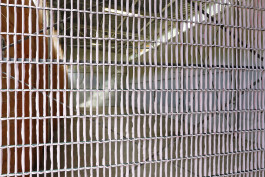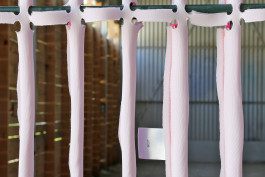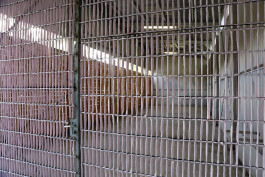





BIEST
Zaunkönig
Exhibition: OZEAN, Berlin, 2014
The project space OZEAN was the product of a select few but crucial alterations of what had been a roofed car park that Hester Oerlemans implemented in 2010; she boarded up much of the structure’s long side and closed the short side, which approaching visitors see first, with a mesh fence. A gate embedded in the latter served as access control, turning OZEAN into a gallery, a space designed—as galleries are—to accommodate works of art, installations, exhibitions. What’s surely rather unusual, however, is that the gate is locked once an exhibition opens. With the exception of the shows in the “SOLOS” series, where viewers are directed toward peepholes drilled into the boarding for optimum visual access to the exhibits, OZEAN encourages—effectively forces—visitors to inspect the art through the fence at one end of the space. The public is invited and excluded at the same time. The works, meanwhile, are locked in, obviating the need for security and conventional opening hours. OZEAN confounds the question of what’s inside and what’s outside; or rather, it highlights with unusual clarity that, here as elsewhere, the position of the one asking the question is crucial. Is the viewer inside OZEAN once he or she steps over the low threshold and under the garage’s roof? Or is he or she outside no matter where?
BIEST thinks through body and space. Space for thought, free space, space for maneuver, private space, art space, public space, spaceship. What and where is inside when the inside is outside, and how do I know where I am? Is a space no one can enter a free space? The concepts that BIEST develops in fashion, architecture, design, art, and interiors are guided by a quest for—and conscious awareness of the need for—unobstructed cognition and contour. In mind and body. Tailored to both. Or confectioned for the mesh fence, as in this project, titled “Zaunkönig.” The formula someone once devised for BIEST’s characteristic practice, opulent minimalism, would seem to describe it aptly. What is opulent in this instance is the minimal intervention. Deploying high-tech materials and the associated techniques of large-scale industrial production, an attire, a shell for the borderline case was manufactured—for the fence along which inside and outside dovetail, forever on the brink of collapsing into each other. Boundary strips are often where the most fertile and lushest biotopes form. BIEST was stuck on the nagging question whether it’s what’s sealed up that’s more interesting or the seal itself. The idea that it’s the indecision between them that’s truly alluring was cast into form, material, volume.
Industrial techniques in bespoke execution tailored to the body, the given architectural structure: that is the threshold from which BIEST in this instance extend their thinking. “Yet in architecture, the threshold designates the bottom crossbar not only of a construction but also of the doorframe. Its signification, then, is twofold and contradictory. It is, on the one hand, the place where a building is founded, where the boundary between inside and outside, private and public, pure and impure, warm and cold, closeted and alien is fixed. On the other hand, the threshold is also the place where that boundary may be crossed, where the enclosure of the four walls is broken up and the ‘confinement of separate being-for-oneself’ is coupled to the ‘unboundedness of passage in all directions’ […].”* The implementation of the boundary demarcation, then, is always also identical to the foundational act. BIEST enlarges the debate over the redefinition of the boundaries between public and private spheres, between visibility and invisibility, and—one might almost say: in the tradition of Daniel Buren—turns the spotlight on what visitors who have come to see the exhibitions at OZEAN ordinarily try not to see. The intervention’s effect is the opposite of what OZEAN is meant for people to do: stepping up to the mesh so that, as one peers through it to eye the works, it fades from view. As the fence itself is brought into focus, the viewer steps back to see from a distance that which used to keep him at a distance. In a world in which the rise of omnipresent media would seem to corrode all boundaries, the implication is clear: our eyes cannot be sharp enough.
* Stalder, Laurent; Präliminarien zu einer Theorie der Schwelle, in: ARCH+ 191/192
Photo: Marike Schuurman
Video: Marike Schuurman








